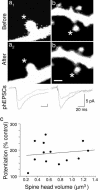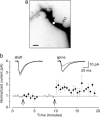Long-term potentiation of exogenous glutamate responses at single dendritic spines
- PMID: 16186507
- PMCID: PMC1242281
- DOI: 10.1073/pnas.0501956102
Long-term potentiation of exogenous glutamate responses at single dendritic spines
Abstract
Long-term increases in the strength of excitatory transmission at Schaffer collateral-CA1 cell synapses of the hippocampus require the insertion of new alpha-amino-3-hydroxy-5-methyl-4-isoxazolepropionate receptors (AMPARs) into the synapse, but the kinetics of this process are not well established. Using microphotolysis of caged glutamate to activate receptors at single dendritic spines in hippocampal CA1 cells, we report the long-lasting potentiation of AMPAR-mediated currents with only a single pairing of photoreleased glutamate and brief postsynaptic depolarization. This potentiation was N-methyl-d-aspartate receptor (NMDAR)-dependent and was reversed with low-frequency photostimulation in an NMDAR-dependent manner, suggesting that it is mediated by the same mechanism(s) as conventional synaptic long-term potentiation. Potentiation of photolytic responses developed rapidly in a stepwise manner after a brief and variable delay (<60 s) at spines, but could not be induced at extrasynaptic sites on the dendritic shaft. Potentiation was accompanied by a concomitant decrease in postsynaptic, polyamine-dependent paired-pulse facilitation of the photolytic currents, indicating that a change in the subunit composition of the AMPARs underlying the response contributed to the potentiation. These changes are consistent with an increase in the proportion of GluR2-containing AMPARs in the spine head. These results demonstrate that activation of postsynaptic glutamate receptors by glutamate is not only necessary, but sufficient, for the induction of NMDAR-dependent long-term potentiation and reveal additional aspects of its expression.
Figures





Similar articles
-
Evidence of calcium-permeable AMPA receptors in dendritic spines of CA1 pyramidal neurons.J Neurophysiol. 2014 Jul 15;112(2):263-75. doi: 10.1152/jn.00578.2013. Epub 2014 Apr 23. J Neurophysiol. 2014. PMID: 24760782 Free PMC article.
-
Long-term potentiation in isolated dendritic spines.PLoS One. 2009 Jun 23;4(6):e6021. doi: 10.1371/journal.pone.0006021. PLoS One. 2009. PMID: 19547754 Free PMC article.
-
N-methyl-D-aspartate receptor-dependent long-term potentiation in CA1 region affects synaptic expression of glutamate receptor subunits and associated proteins in the whole hippocampus.Neuroscience. 2006 Sep 1;141(3):1399-413. doi: 10.1016/j.neuroscience.2006.04.070. Epub 2006 Jun 12. Neuroscience. 2006. PMID: 16766131
-
Estradiol and the relationship between dendritic spines, NR2B containing NMDA receptors, and the magnitude of long-term potentiation at hippocampal CA3-CA1 synapses.Psychoneuroendocrinology. 2009 Dec;34 Suppl 1:S130-42. doi: 10.1016/j.psyneuen.2009.06.003. Psychoneuroendocrinology. 2009. PMID: 19596521 Free PMC article. Review.
-
Expression mechanisms underlying NMDA receptor-dependent long-term potentiation.Ann N Y Acad Sci. 1999 Apr 30;868:515-25. doi: 10.1111/j.1749-6632.1999.tb11320.x. Ann N Y Acad Sci. 1999. PMID: 10414328 Review.
Cited by
-
Calcium control of triphasic hippocampal STDP.J Comput Neurosci. 2012 Dec;33(3):495-514. doi: 10.1007/s10827-012-0397-5. Epub 2012 May 19. J Comput Neurosci. 2012. PMID: 22610510
-
The Impact of Sparse Coding on Memory Lifetimes in Simple and Complex Models of Synaptic Plasticity.Biol Cybern. 2022 Jun;116(3):327-362. doi: 10.1007/s00422-022-00923-y. Epub 2022 Mar 14. Biol Cybern. 2022. PMID: 35286444 Free PMC article.
-
Flashy science: controlling neural function with light.J Neurosci. 2005 Nov 9;25(45):10358-65. doi: 10.1523/JNEUROSCI.3515-05.2005. J Neurosci. 2005. PMID: 16280572 Free PMC article. Review. No abstract available.
-
Ras and Rap signaling in synaptic plasticity and mental disorders.Neuroscientist. 2011 Feb;17(1):54-78. doi: 10.1177/1073858410365562. Epub 2010 Apr 29. Neuroscientist. 2011. PMID: 20431046 Free PMC article. Review.
-
Dendritic compartment and neuronal output mode determine pathway-specific long-term potentiation in the piriform cortex.J Neurosci. 2009 Oct 28;29(43):13649-61. doi: 10.1523/JNEUROSCI.2672-09.2009. J Neurosci. 2009. PMID: 19864577 Free PMC article.
References
Publication types
MeSH terms
Substances
LinkOut - more resources
Full Text Sources
Other Literature Sources
Miscellaneous

